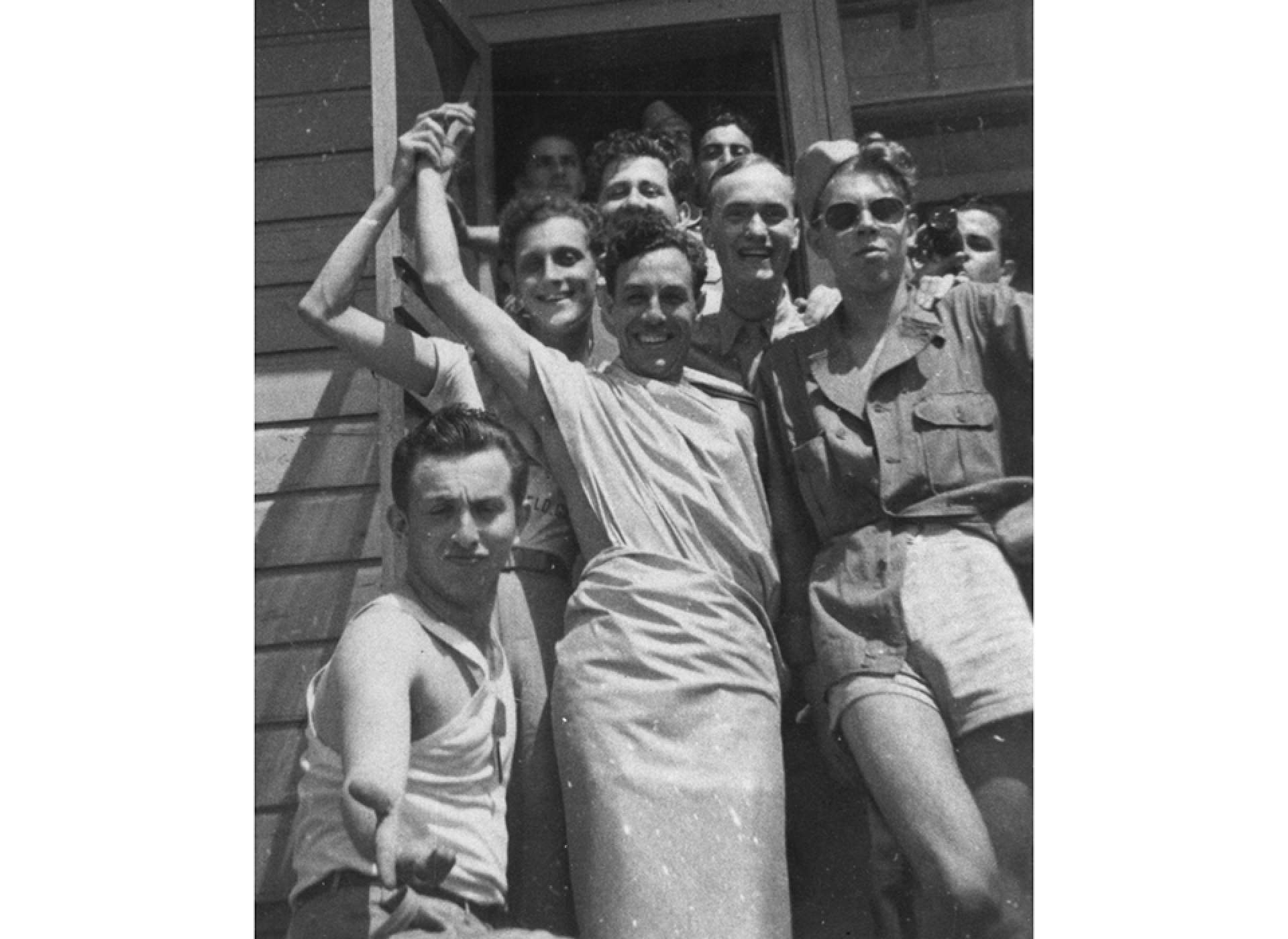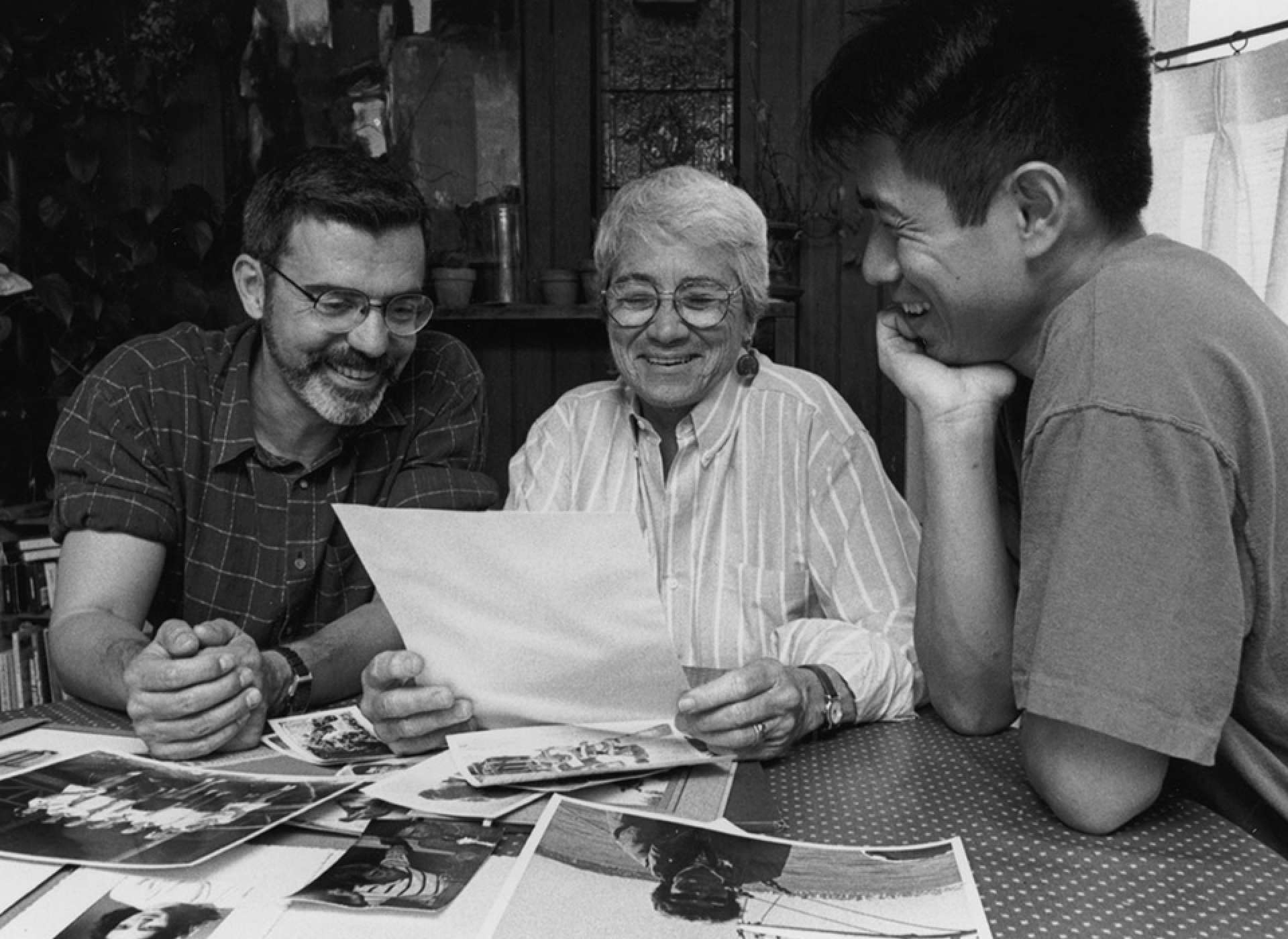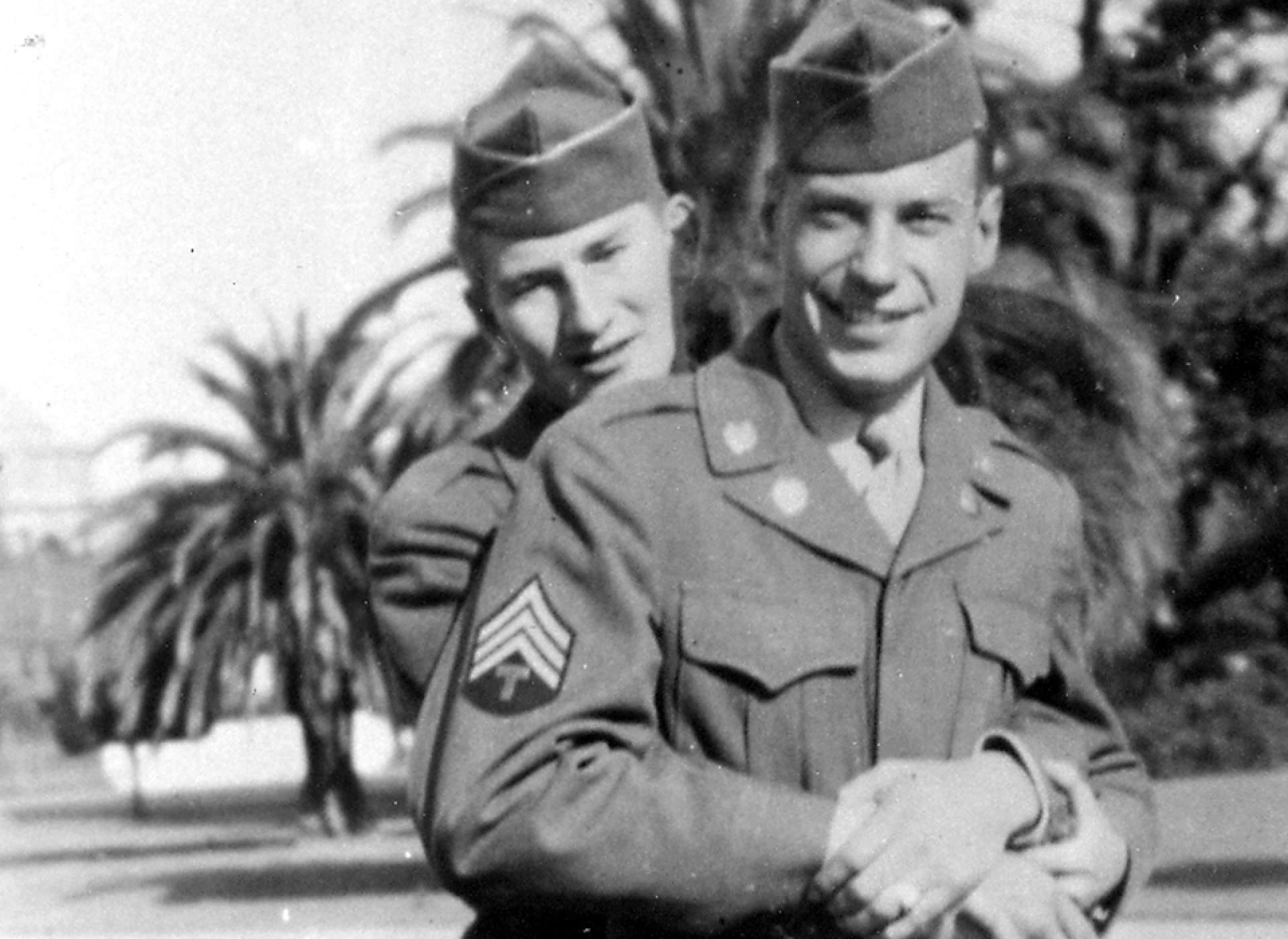Which Of The Following Is True Of Discrimination In The U.s. Armed Services During World War Ii?
Skip to Primary Content of WWII
Coming Out Under Burn: The Story of Gay and Lesbian Service Members
Gay and Lesbian soldiers faced extraordinary bigotry during World War Two. Most found new communities of people and thrived despite the oppression. Notice the motion-picture show Coming Out Under Fire that shares their story.

"Be invisible."
Marvin Liebman, US Army Air Corps
At the age of nineteen, Marvin Liebman was drafted into the Special Services, US Ground forces Air Corps during the waning years of Earth War II. Liebman and more than than 9,000 American service members, nevertheless, eventually were given a department-8 'bluish discharge' for beingness homosexual. The 1994 documentary, Coming Out Under Fire, gives vocalization to the experiences of thousands of gay and lesbian service members who joined the military during World State of war II, a story that is largely ignored by historians and museums across the country.
The moving picture is based on a volume written by historian Allan Bérubé. However, information technology is of import to identify the film into its historical context. In 1993, the United States was debating the discriminatory "Don't ask, Don't Tell" policy regarding homosexuals in the modern military. The intense nation-wide contend resulted in congressional hearings where each member of the Joint Chiefs of Staff voiced supportive opinions of the policy and a reassertion of the policy by President Clinton. This motion-picture show can and should be seen as not only a social commentary against the policy, but also an expression of the human cost behind such discrimination.
The picture takes the states back to Earth War Two for a detailed await at the origins of the policy. Nosotros hear from 9 veterans who, like all Americans, were asked to practise their part. At the time, homosexuality was classified as a mental illness by the medical customs. Mental illness was 1 condition that disqualified young people from service.
"Whatever attitudes we had about not-involvement immediately disappeared [later on pearl harbor] and we became as much a part of the state of war endeavor equally everyone else."
Tom Reddy, United states Marine Corps
The United States armed forces, hoping to screen out mentally ill individuals, asked every potential service member questions on their sexuality. People who were gay and lesbian were forced to answer questions vaguely, or lie about their sexuality, in order to be allowed to serve; otherwise, they would run the risk of being sent dwelling and branded equally "sex perverts."
Past the middle of the war, the military sought new ways to target and expel homosexuals. Instead of charging individuals with sodomy, a court-martialed offense, the armed forces began identifying suspected homosexuals equally psychopaths. In other words, instead of charging service members with a crime of beliefs or action, the armed services charged service members with a crime of existence. Such a move created an efficient arrangement of discrimination and prosecution of homosexual members of the military.
Service members who were persecuted by a section 8 bluish discharge were purged from bases and units and sent to mental institutions and make-shift quarantined brigs where they suffered from isolation, depression, and humiliation, and were stripped of their rights and nobility.
"We felt liberated once we had discovered our own secret. We were gay."
Tom Reddy, The states Marine Corps
Despite the threat of persecution, gay and lesbian service members thrived during World War 2. Equally with most immature soldiers, many had never left their homes earlier and the state of war provided them an opportunity to find community, esprit, and, in some cases, beginning loves. These new friendships gave gay and lesbian GIs refuge from the hostility that surrounded them and immune for a singled-out sub-civilization to develop within the military. Service members on every warfront enjoyed drag bear witness entertainment; an entire gay dictionary was adult from the writings of Dorothy Parker; and eventually an underground queer newspaper emerged. The "Myrtle Beach Bitch" or "Myrtle Embankment Belle" covertly shared news and stories between bases and units.
"This is the Army" was a GI show put on during Globe War II. Soldiers represented female characters in military plays and some homosexual soldiers institute refuge from rigid gender roles. Image courtesy of Friends of the National WWII Memorial.
Many lesbians in the armed services rose to positions of influence. Phyllis Abry, for example, was featured in propaganda articles considering she represented the ideals of a WAAC. Unknown to the Army, they too selected Abry'southward lover equally the other ideal WAAC to be featured together in the propaganda. The irony that the military selected two homosexuals to represent the ideal image of the Women's Army Auxiliary Corps was not lost on Abry.
For many, World War II marked simply the beginning of life-long struggles with their identity. The systematic purges of bases and units ripped autonomously the communities and relationships that had been developed over shared sacrifices. Bluish discharges followed veterans their entire lives and fabricated them ineligible for all veteran services. In 1953, President Eisenhower signed Executive Order 10450, that banned homosexuals from federal employment. Over five,000 federal employees lost their jobs over accusations of homosexuality. These federal discriminatory deportment drove LGBTQ people farther into the shadows of society and emboldened constabulary enforcement and politicians, who became more violent toward gay and lesbian citizens.
On June 28, 1969 police force raided the Stonewall Inn in the Greenwich Village neighborhood of New York Metropolis. Patrons of the gay bar fought back and sparked a violent insurgence that started the gay rights movement in the The states.
Gay and lesbian veterans of World State of war II became some of the first to fight armed forces discrimination and blueish discharges in the years post-obit World State of war II. However, military discrimination became a cornerstone consequence for the LGBTQ civil rights movement in the decades post-obit the Vietnam War. The fence continued until 2010, when "Don't ask, Don't tell" was repealed and armed forces service members could serve openly.
At that place is nada more patriotic than doing your duty in the face of extraordinary odds. June, in detail, is a time that LGBTQ individuals defy the odds and celebrate diversity and pride. Don't let the age of the film fool you: Coming Out Nether Burn does a great service for our efforts to share a more complete history of the state of war that changed the globe. My only hope is that organizations around the country commit to capturing the voices of gay, lesbian, and transgender veterans and that we detect a place in our history to honor their service equally well.
-

Clark and Buddies, US Army Air Strength. Image courtesy of Deep Focus Productions.
-

Writer Allen Be'rube', Veteran Sarah Davis, and pic maker Arthur Dong. Image courtesy of Deep Focus Productions.
-

Image courtesy of Friends of the National WWII Memorial.

Alan Turing and the Hidden Heroes of Bletchley Park: A Conversation with Sir John Dermot Turing
Nosotros sabbatum down with Sir John Dermot Turing, Alan Turing's nephew and author of a new book on Bletchley Park, to discusses his uncle's role pivotal role in computer science and his persecution for being gay in the 1950s.
Learn More

Correspondent
Adam Foreman
Adam Foreman is the former Educatee Programs Specialist at The National WWII Museum.
Larn More
Source: https://www.nationalww2museum.org/war/articles/gay-and-lesbian-service-members
Posted by: fishervered1989.blogspot.com
















0 Response to "Which Of The Following Is True Of Discrimination In The U.s. Armed Services During World War Ii?"
Post a Comment